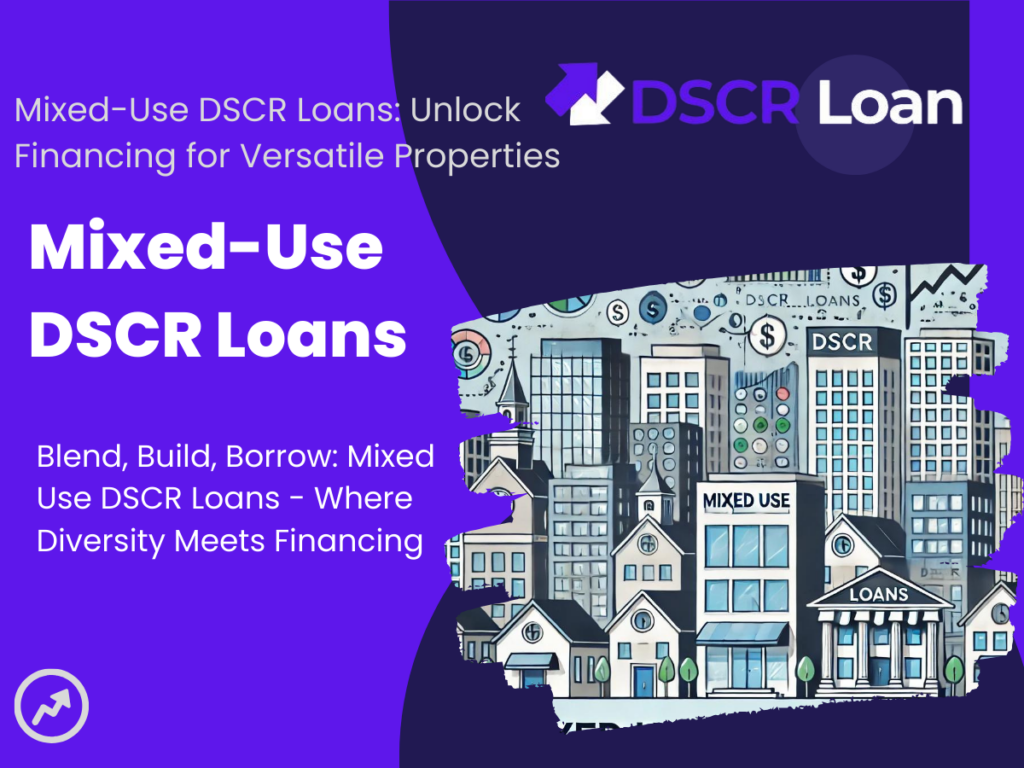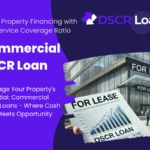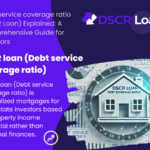Mixed-use DSCR loans provide financing for properties combining residential and commercial spaces, focusing on the property’s income potential. These loans offer flexible terms, easier qualification for complex investments, and the ability to finance versatile properties like retail-residential and live-work spaces.
Mixed Use DSCR Loans: Unlocking Financing for Versatile Properties
Have you ever walked down a bustling city street and noticed buildings with shops on the ground floor and apartments above? These are mixed-use properties, and they’re becoming increasingly popular in urban areas. But how do investors finance these unique real estate gems? Enter the world of mixed-use DSCR loans – a flexible financing option that’s changing the game for property investors.
What Are Mixed-Use DSCR Loans?
Let’s break it down. DSCR stands for Debt Service Coverage Ratio, a key metric lenders use to assess a property’s ability to cover its loan payments. Mixed-use properties combine residential and commercial spaces under one roof. So, a mixed-use DSCR loan is a financing option tailored for these multifaceted properties, focusing on their income-generating potential rather than just the borrower’s personal finances.
The Anatomy of a Mixed-Use Property
Before we dive deeper, let’s paint a picture of what we mean by “mixed-use”:
- Ground floor: Retail shops, cafes, or offices
- Upper floors: Apartments or condos
- Sometimes includes: Parking facilities, community spaces, or even hotels
These properties are like mini-communities, offering a blend of living, working, and shopping all in one location.
Why Choose a Mixed-Use DSCR Loan?
You might be wondering, “Why not just go for a traditional commercial loan?” Well, mixed-use DSCR loans offer some unique advantages:
- Flexibility: They cater specifically to the hybrid nature of mixed-use properties.
- Focus on Property Performance: Lenders care more about the property’s income than your personal financial statement.
- Potential for Better Terms: Strong cash flow can lead to more favorable loan conditions.
- Simplified Qualification: Ideal for investors with complex tax situations or multiple properties.
How DSCR Works for Mixed-Use Properties

Understanding DSCR is crucial when you’re considering this type of loan. Here’s a simple breakdown:
DSCR = Net Operating Income (NOI) / Annual Debt Service
For mixed-use properties, calculating NOI can be a bit tricky. You’ll need to consider:
- Rental income from apartments
- Lease payments from commercial tenants
- Parking fees (if applicable)
- Any other income the property generates
Then, subtract all operating expenses, but don’t include the mortgage payment. The result is your NOI.
Most lenders look for a DSCR of at least 1.25, meaning the property generates 25% more income than it needs for loan payments. But here’s the kicker – mixed-use properties often have the potential for higher DSCRs due to their diverse income streams.
Case Study: Success with a Mixed-Use DSCR Loan
Let’s look at a real-world example. Sarah, an experienced real estate investor, had her eye on a rundown building in an up-and-coming neighborhood. The property had two retail spaces on the ground floor and four apartments above. Here’s how she used a mixed-use DSCR loan to make it happen:
- Property Purchase: $1,000,000
- Renovation Costs: $200,000
- Total Project Cost: $1,200,000
- Down Payment: $300,000 (25%)
- Loan Amount: $900,000
After renovations, Sarah was able to lease both retail spaces and all four apartments. Her new NOI was $120,000, and her annual debt service was $75,000, giving her a DSCR of 1.6. This strong DSCR not only helped her secure the loan but also got her a competitive interest rate.
Types of Mixed-Use Properties Eligible for DSCR Loans
| Property Type | Description | Eligible for DSCR Loan? |
|---|---|---|
| Office-Retail | Combines office space with retail storefronts or restaurants | Yes |
| Office-Residential | Combines office space with residential units (e.g., apartments, condos) | Yes |
| Retail-Residential | Combines retail stores with residential units (e.g., townhouses, lofts) | Yes |
| Industrial-Office | Combines industrial space with office space or light manufacturing facilities | Yes |
| Industrial-Storage | Combines industrial space with storage facilities (e.g., warehouses, self-storage) | Yes |
| Hotel-Commercial | Combines hotel rooms with commercial spaces (e.g., restaurants, retail) | Yes |
| Hotel-Residential | Combines hotel rooms with residential units (e.g., condos, apartments) | Yes |
| Mixed-Use Tower | Combines multiple uses (e.g., office, retail, residential, hotel) in a single tower or building | Yes |
| Live-Work Spaces | Combines residential units with commercial spaces (e.g., artist studios, home-based businesses) | Yes |
Mixed-use properties come in all shapes and sizes. Here are some common types that might qualify for a DSCR loan:
- Retail + Residential: Think of a building with a coffee shop on the ground floor and apartments above.
- Office + Residential: Picture a small law firm occupying the first floor with condos on upper levels.
- Live-Work Spaces: These are trendy units where people can operate a business and live in the same space.
- Main Street Buildings: Classic downtown structures with storefronts below and living spaces above.
Qualifying for a Mixed-Use DSCR Loan
So, you’ve got your eye on a mixed-use property. How do you qualify for a DSCR loan? Here’s what lenders typically look for:
- Strong DSCR: Aim for at least 1.25, but higher is better.
- Decent Credit Score: While less critical than with traditional loans, a score of 660+ is usually preferred.
- Down Payment: Expect to put down 20-25% of the property’s value.
- Property Condition: The building should be in good shape and up to code.
- Occupancy Rates: High occupancy in both residential and commercial spaces is a big plus.
- Location: Properties in desirable, high-traffic areas are more likely to qualify.
The Application Process
Ready to apply? Here’s what the process typically looks like:
- Gather Your Documents: This includes property financials, rent rolls, and lease agreements.
- Property Valuation: The lender will order an appraisal to determine the property’s worth.
- Underwriting: The lender reviews all the information to assess the loan’s risk.
- Loan Approval: If everything checks out, you’ll get the green light.
- Closing: Sign the papers and get your funds!
Pros and Cons of Mixed-Use DSCR Loans
| Pros | Cons |
|---|---|
| Flexibility: Mixed-use DSCR loans allow for a combination of different property uses, providing flexibility in investment strategies and potential for increased cash flow. | Complexity: Mixed-use properties can be complex to manage, requiring specialized expertise and resources. |
| Increased Cash Flow: By combining multiple revenue streams, mixed-use properties can generate more cash flow than single-use properties. | Higher Risk: Mixed-use properties often come with higher risk due to the complexity of managing multiple uses and tenants. |
| Potential for Higher Appreciation: Mixed-use properties can appreciate in value faster than single-use properties due to their unique combination of uses. | Higher Upfront Costs: Mixed-use developments often require significant upfront investments in construction, land acquisition, and permitting. |
| Tax Benefits: Mixed-use properties can offer tax benefits, such as accelerated depreciation and interest deductions. | Tenant Concentration Risk: If a single tenant or use dominates the property, there may be a high concentration of risk if that tenant leaves or defaults. |
| Increased Property Value: By combining multiple uses, mixed-use properties can increase their overall value, making them more attractive to investors and lenders. | Regulatory Challenges: Mixed-use properties may face regulatory challenges, such as zoning restrictions and permit requirements, which can add complexity and cost to the development process. |
| Longer Lease Terms: Mixed-use properties may attract tenants with longer lease terms, providing stability and predictability for the property owner. | Higher Maintenance Costs: Mixed-use properties often require more maintenance and upkeep due to the variety of uses and tenants. |
Like any financing option, mixed-use DSCR loans have their ups and downs. Let’s weigh them:
Pros:
- Easier qualification for complex investments
- Focus on property performance over personal income
- Potential for larger loan amounts
- Ideal for properties with strong cash flow
Cons:
- Potentially higher interest rates than conventional loans
- Stricter requirements for property performance
- May require larger down payments
- Less flexibility in loan terms
Maximizing Your DSCR for Better Loan Terms
Want to boost your chances of approval and snag better terms? Try these strategies:
- Optimize Your Tenant Mix: Aim for a balance of stable commercial tenants and residential occupants.
- Improve Energy Efficiency: Lower operating costs can boost your NOI and DSCR.
- Raise Rents (If Market Allows): Higher income means a better DSCR, but be careful not to price yourself out of the market.
- Reduce Vacancies: Implement effective marketing strategies to keep occupancy high.
- Consider Value-Add Improvements: Strategic renovations can justify higher rents and improve property value.
Common Pitfalls to Avoid
When pursuing a mixed-use DSCR loan, steer clear of these common mistakes:
- Overestimating Income: Be realistic about potential rental income to avoid falling short on DSCR requirements.
- Underestimating Expenses: Account for all operating costs, including potential increases in property taxes or insurance.
- Ignoring Market Trends: Consider how economic shifts might affect your property’s performance and DSCR.
- Neglecting Due Diligence: Thoroughly research the property and market before committing to a loan.
- Overlooking Prepayment Penalties: Understand the terms of your loan, including any fees for early repayment.
The Future of Mixed-Use DSCR Loans
As urban areas continue to evolve, mixed-use properties are becoming increasingly popular. This trend is likely to drive innovation in the DSCR loan market. Here’s what we might see:
- More Flexible Terms: Lenders may offer more customized options to suit different mixed-use scenarios.
- Integration of Technology: Expect to see more use of AI and big data in assessing property performance and risk.
- Green Incentives: Properties with sustainable features may qualify for better loan terms.
- Focus on Community Impact: Lenders might consider a property’s contribution to neighborhood vitality.
Read Also: Residential DSCR loans: What is it, Expert Advice & How to Apply
Conclusion
Mixed-use DSCR loans offer a unique financing solution for investors looking to tap into the growing mixed-use property market. By focusing on the property’s income-generating potential, these loans can open doors that might remain closed with traditional financing options. While they come with their own set of challenges, the potential rewards – both in terms of financing and property performance – can be significant.
As with any major financial decision, it’s crucial to do your homework, understand the market, and carefully consider your long-term investment goals. With the right approach, a mixed-use DSCR loan could be your ticket to a diverse and profitable real estate portfolio.
Also Read: Unlock Real Estate Wealth: Master Residential DSCR Loans for Investors
FAQs
What’s the minimum DSCR needed for a mixed-use property loan?
While it can vary by lender, most look for a minimum DSCR of 1.25. However, a higher DSCR can lead to better loan terms and easier approval.
Can I get a mixed-use DSCR loan for a property I plan to live in?
Yes, it’s possible. Some lenders offer DSCR loans for owner-occupied mixed-use properties, but terms and qualifications may differ from non-owner-occupied loans.
How does the commercial portion of a mixed-use property affect the DSCR calculation?
Commercial tenants often have longer leases and may provide more stable income, which can positively impact your DSCR. However, potential vacancies in commercial spaces can also have a larger effect on your DSCR than residential vacancies.
Are mixed-use DSCR loans harder to get than single-use commercial or residential loans?
Not necessarily harder, but different. Mixed-use DSCR loans require lenders with experience in both commercial and residential real estate. While the process might be more complex, the focus on property performance can make qualification easier for some investors.
How often will my DSCR be reviewed after I get the loan?
Most lenders review DSCR annually, but some may require more frequent reviews, especially for higher-risk properties or during economic downturns. It’s important to maintain a strong DSCR throughout the loan term to avoid potential default situations.



